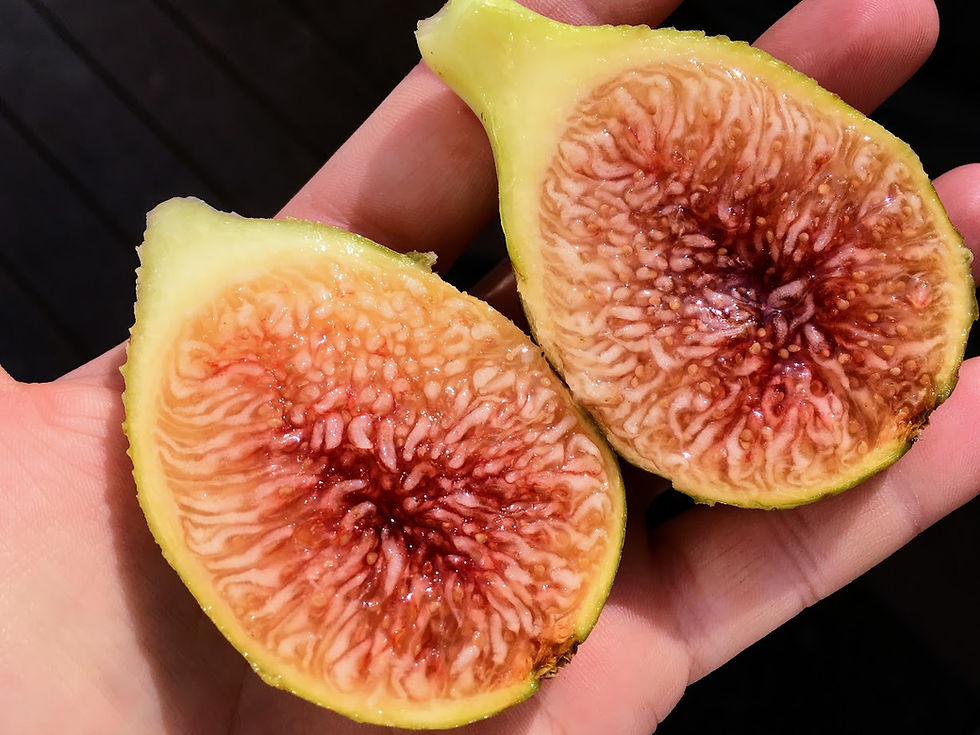The Fruity Honey Fig Flavor Profile: The Varieties & Meaning
Updated: 3 days ago
To help new growers choose fig varieties, experienced growers have grouped similar-tasting figs into flavor profiles (Sugar, Honey, and Berry). However, these are guidelines, not strict rules, as growing conditions, harvesting at the proper time, and pollination can influence their taste.
Figs have a complex flavor–a mix of dried fruits, melons, berries, and sugar. There are over 1000 varieties of figs, each with its own unique flavor. If you haven’t already, read about the different fig flavor profiles and what figs taste like in the article linked below.
This article is about the “Fruity Honey” fig flavor profile.
Fruity Honey Fig Flavor Profile
This fig profile is centered around honey figs but with an added berry flavor. Much like how Sugar Honey figs enhance the classic Honey profile, Fruity Honey figs offer an upgrade to the Honey category. They’re more complex, and as any fig enthusiast will tell you, berry notes are often a step up.
I describe this profile as "fruity" because it’s not quite the full-on berry burst you’d get from varieties like Cherry, Complex Berry, or Melon Berry. It’s subtler, but when properly ripened, it delivers something unique and intriguing. If you’re collecting varieties, this one is definitely worth adding to your collection, though it’s pretty rare to find.
Related: The Best Tasting Fig Varieties
Here are the varieties that fall under this category:
Bebera Branca

Bebera Branca is a Portuguese variety that truly shines when caprified. It’s an exceptional fig, and I’m surprised more growers haven't chosen to grow it. I’d especially recommend it for dry climates. However, I am trialing it once again for evaluation in humid areas. This honey fig has the potential to develop a bold berry flavor, surpassing the usual mild fruitiness the varieties in this flavor profile have.
LSU Hollier
LSU Hollier is a product of the LSU breeding program, which used Celeste as the main parent to improve it, but comparing LSU Hollier to Celeste is like comparing apples to oranges. Celeste is the classic variety of the Sugar fig flavor profile.
However, as my LSU Hollier tree gets more mature and the better the fruits dry on the tree, the less they resemble honey figs and more toward Celeste's flavor profile. The longer they ripen, the more berry flavors you'll detect, and the honey/melon tones will disappear. It's quite a nice eating experience.
However, they can split or give growers a reason to harvest them earlier than I'd prefer.
During dry periods, LSU Hollier performs well and produces fruit of consistently high fruit quality. The figs can ripen very early alongside the earliest like Ronde de Bordeaux or Florea. It also produces a light breba crop in favorable years that rivals the quality of the main. Overall, LSU Hollier is a high-quality variety that could offer a different eating experience than what you may already be growing.
Albo
This Italian heirloom fig is both early-ripening and flavorful, but its open eye makes it a bit less suitable than the Hollier for humid climates. However, it’s noticeably tastier and would be a great option for a dry climate.
Related: Early Ripening Fig Varieties
According to Condit's monograph:
According to Gallesio, it is one of the few varieties found along the whole coast of Italy, but not in France or Spain. Gasparrini described Fico Albo with Fico Trojano in parentheses, and also treated Biancolini as a distinct variety. Eisen regarded it as one of the best Italian figs, especially well regarded in the markets of Pavia and Milan.

Pecciolo Bianco
Pecciolo Bianco is an Italian fig from Carmignano. Very tasty and promising.
From Condit's monograph:
Described and figured by Baldini (1953) from Firenze, Italy. Tree of medium size, with open head and green terminal buds. Leaves mostly 5 lobed; upper lobes spatulate, lower lobes triangular; base shallowly cordate. Figs pyriform, with short, slender neck; stalk 5/8 inch in length; eye closed, scales rosy; color light yellow; pulp red, flavor moderately sweet; seeds many. Highly regarded for table use.

Monaco
The Monaco fig is a well-regarded European variety, prized for its historical significance and widespread cultivation. It produces large, green, and yellow-skinned pear-shaped fruit.
While it has a reputation for high productivity and solid size, the fig's open eye and pear shape make it prone to splitting and internal spoilage, particularly in humid, wet climates. Though it demonstrates some rain resistance, its susceptibility to mold and insect issues due to the open eye limits its reliability in areas with high moisture. Despite its unique flavor and reliable production, the Monaco fig may perform best in drier climates, where its fruit quality can be more consistently maintained.
According to Condit's monograph:
According to Gallesio, this variety originated in the district of Lunigiana, where the fruit was highly esteemed. It was grown at Genoa and other places in northern Italy, but apparently has not been much distributed in France. Hogg reported Monaco as a coarse fig, inclined to split, and not a first-rate variety. On the other hand, Wythes classed it as superior to Brown Turkey in flavor, but not so reliable in production.




